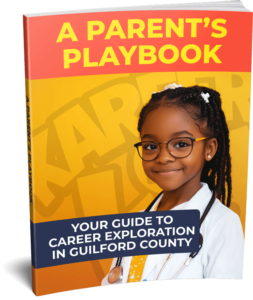Guilford County Schools (GCS) is committed to making sure every student graduates with a clear plan for life after high school. Two powerful ways GCS supports this are through Career & Technical Education (CTE) pathways and dual enrollment opportunities. Together, these options help students explore careers, earn credentials, and even complete college courses while still in high school.
What Are CTE Pathways?
CTE pathways are organized around high-demand industries. Students can choose courses that match their interests and lead to industry-recognized certifications, internships, and career experience.
Some examples of CTE pathways offered across GCS include:
-
Health Science (nursing, pharmacy tech, sports medicine)
-
Information Technology (cybersecurity, networking, programming)
-
Advanced Manufacturing & Engineering (robotics, design, logistics)
-
Business & Finance (accounting, entrepreneurship, marketing)
-
Agriculture & Environmental Science
-
Arts, Media & Communication
By completing a pathway, students graduate with more than just a diploma — they gain skills employers want and a head start toward college or a career.
Dual Enrollment: Earning College Credit in High School
Through partnerships with local colleges, students can take tuition-free college courses while still in high school. This is called dual enrollment, and it saves families both time and money.
Options include:
-
Career & College Promise (CCP): Available at GTCC and other partner colleges. Students take courses that count for both high school and college credit.
-
Early Colleges & Middle Colleges: Students take a mix of high school and college classes, often graduating with an associate degree or up to two years of transferable college credit.
-
Advanced Placement (AP) & International Baccalaureate (IB): While not college classes themselves, passing AP/IB exams can earn college credit at many universities.
Why This Matters for Families
-
Saves Money: Dual enrollment courses are tuition-free, reducing the cost of college.
-
Boosts Confidence: Students experience college-level work before graduating high school.
-
Opens Doors: CTE certifications + college credits can lead to jobs, apprenticeships, or faster college completion.
-
Career Exploration: Students test out fields of interest before committing to a major or career.
Next Steps for Families
-
Talk to your School Counselor or CTE Coordinator about which pathways fit your student’s interests.
-
Attend the Choice Fair (Oct 22, 2025) to explore program options.
-
Ask about Career & College Promise (CCP) and how your student can get started with dual enrollment.
-
Plan Early: Some programs have limited spots and early application windows.
👉 Takeaway: CTE and dual enrollment are not “extras” — they are game changers. They help students leave high school with college credit, career credentials, and a competitive edge for the future.




